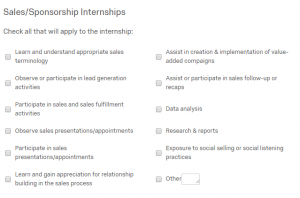by Kirk Wakefield – January 2017
After arranging & supervising hundreds of sports internships for the last dozen or so years, Dr. Darryl Lehnus and I devised a system that works well for us.
Ideally, partners provide the internship with the same objective of developing and evaluating talent in view of future employment there or elsewhere. Our partners see intern successes as their successes, as it reflects on their abilities to train, motivate, and model excellent performance.
 Among others, the Pittsburgh Pirates B.U.C.S Academy and the New York Mets are ahead of the game in organizing internships and recruiting to careers. While many teams and companies provide summer internships, the Houston Texans (sponsorships) and Houston Astros (CRM) provide 9-12 month postgraduate internships specifically for our graduates to gain more in-depth training before launching careers.
Among others, the Pittsburgh Pirates B.U.C.S Academy and the New York Mets are ahead of the game in organizing internships and recruiting to careers. While many teams and companies provide summer internships, the Houston Texans (sponsorships) and Houston Astros (CRM) provide 9-12 month postgraduate internships specifically for our graduates to gain more in-depth training before launching careers.
Our best-in-class partnerships do five things:
- Budget for internships.
- Show up every year to interview.
- Provide awards or incentives. (Examples: See StubHub & MLBAM.)
- Serve as mentors.
- Initiate follow-up with interviews to (a) hire or (b) refer for hiring.
Five Not-So-Easy Steps
From a process standpoint, partners follow these five steps. We’ll explain each in turn.
- Prepare students for careers.
- Determine parameters & responsibilities.
- Define, communicate and evaluate on criteria that predict success.
- Hold students responsible.
- Review insights & follow-through with students.
Prepare students for careers
Ask employers what they want. Continue to ask.
Too many prepare students for sports marketing or sports management jobs. The only problem is no entry level positions exist for “sports marketer” or “sports manager.” Entry level positions do exist in ticket sales, sponsorship sales & service/fulfillment, CRM, and analytics. Design coursework and programs accordingly.
Business schools have courses in professional selling, database management, statistics and predictive modeling, and data visualization (Excel, Tableau, etc.). Take advantage of these courses in planning curriculum requirements. When employers see you take them seriously, they’ll line up for your students.
Determine Parameters & Responsibilities
Once employers agree, we send them a link to an online form to identify the supervisor, time frame (start, finish, hours per week, pay or course credit), and responsibilities. Most likely you’ve already discussed this, but best to not be surprised at the end of the term that the internship didn’t include a vital part of what they needed to experience.
After selecting the type of internship, the employer completes the appropriate section for what the intern will do. Our forms are below.
Define, communicate and evaluate criteria for success
Every year the National Association of Colleges & Employers (NACE) publish a list of attributes most desired of new hires. These could differ among some, but odds are they are the same. With a little adaptation, we use these for midterm and final evaluations by the intern’s direct supervisor.
Responses on the primary criteria (below) are shared with the intern in a meeting with the academic advisor. We also ask about punctuality, attitude, performance, and overall grade from the direct supervisor of the internship at the employer. The entire form may be downloaded here.
Sports Internship Evaluation Criteria
Specific to our own preparation and values, we ask students to be 2nd milers. When asked to do something (walk a mile), go above and beyond expectations (go the second mile). Supervisors rate the intern accordingly (below).
Hold students responsible
Students should perform well in the internship. We expect that.
We also expect them to reflect on what they learn. Keeping a daily or weekly journal is recommended.At the end of the term, students must submit the S3 Internship Report Form (click to download) regarding a weekly log of hours, assignments, volunteering, accomplishments, application of class material, issues (problems or challenges & resolutions), culture, behavioral adaptation, recommendations, and net promoter score rating for the internship.
Review insights & follow-through with students
Meet with each student to get his or her take on the evaluation provided in Step 3. Usually there are no surprises. Employers do a good job of picking up on areas for improvement that you’ve likely noticed in class. So, it’s nice to have someone else see it and say it.
Generally, these are great times to encourage students in careers. On occasion, you can use these to give appropriate kicks in the pants. We’ve seen these have fairly drastic effects on capable students who needed to get with the program. On occasion, you find some who need to find another program. The wide world of sports, perhaps the same as other industries (but we think more so),demands a high level of commitment. We help students by holding them to a high standard.
Conclusion
Providing good internship experiences takes effort on the part of the academic advisor, student, and employer. But, working together, internships are the foundation for successful careers. No class, book or assignment can substitute for on-the-job reality training.
The very best part of what we do is to see students succeed in their careers.
Feel free to borrow, steal, or adapt any or all of the attached materials! If you’ve found other things that work well, please let us know!







